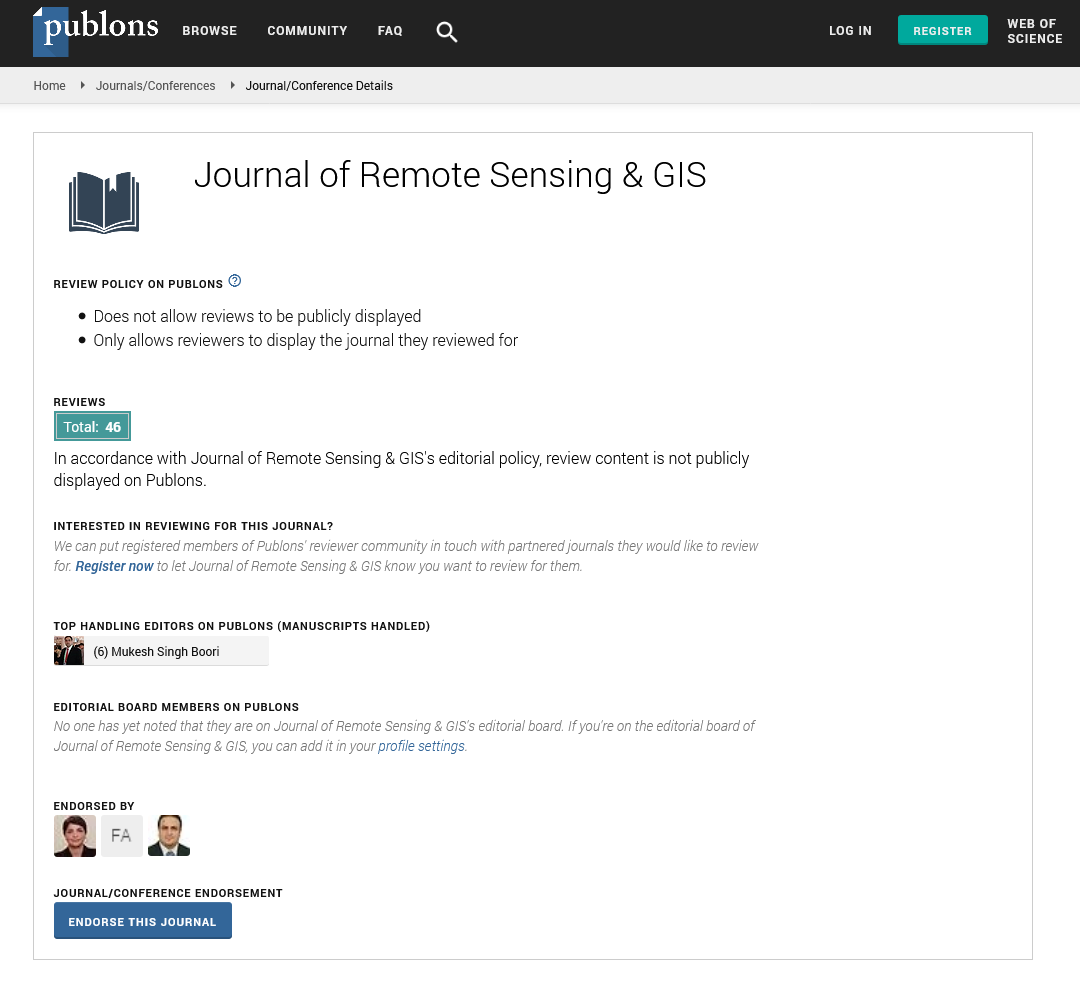Indexed In
- Open J Gate
- RefSeek
- Hamdard University
- EBSCO A-Z
- OCLC- WorldCat
- Publons
- International Scientific Indexing
- Euro Pub
- Google Scholar
Useful Links
Share This Page
Journal Flyer

Open Access Journals
- Agri and Aquaculture
- Biochemistry
- Bioinformatics & Systems Biology
- Business & Management
- Chemistry
- Clinical Sciences
- Engineering
- Food & Nutrition
- General Science
- Genetics & Molecular Biology
- Immunology & Microbiology
- Medical Sciences
- Neuroscience & Psychology
- Nursing & Health Care
- Pharmaceutical Sciences
Commentary Article - (2024) Volume 13, Issue 1
Role of Odyssey Geodynamics in Revolutionizing Remote Sensing Technologies
Yiwen Li*Received: 01-Mar-2024, Manuscript No. JGRS-24-24555; Editor assigned: 04-Mar-2024, Pre QC No. JGRS-24-24555 (PQ); Reviewed: 18-Mar-2024, QC No. JGRS-24-24555; Revised: 25-Mar-2024, Manuscript No. JGRS-24-24555 (R); Published: 01-Apr-2024, DOI: 10.35248/2469-4134.24.13.332
Description
The Earth with its huge and intricate geological processes is in a constant state of motion. These dynamic movements have been a longstanding pursuit for scientists, and recent advancements in technology have provided unprecedented tools for such exploration. One of the most revolutionary approaches is the utilization of remote sensing from space to gain insights into Earth's geodynamics. The fusion of geodynamics and remote sensing technologies. Geodynamics, the study of the Earth's dynamic processes, encompasses a broad range of phenomena, including plate tectonics, earthquakes, volcanic activity, and the subtle deformations of the Earth's surface. Remote sensing, on the other hand, involves the acquisition of information about an object or phenomenon without physical contact. When these two fields converge, they open up possibilities for understanding the Earth's intricate movements and changes. Satellites orbiting high above the Earth's surface act as the eyes in the sky, capturing a wealth of data that can be harnessed for geodynamic studies. These satellites are equipped with a variety of sensors, including optical, radar, and infrared instruments, enabling scientists to observe and measure changes in the Earth's surface with unprecedented detail. The combination of geodynamics and remote sensing has given rise to a range of applications that contribute to our understanding of Earth's dynamics.
Plate tectonics, a fundamental aspect of geodynamics, involves the movement and interaction of the Earth's lithospheric plates. Remote sensing satellites play a role in monitoring plate boundaries and the associated geological phenomena. For instance, Synthetic Aperture Radar (SAR) mounted on satellites can detect ground deformation with millimeter-level precision. This capability is invaluable for tracking tectonic plate movements, identifying potential earthquake zones and studying the aftermath of seismic events. Volcanic activity, another geodynamic process, can be observed and monitored from space, providing information for hazard assessment and disaster management. Thermal infrared sensors onboard satellites can detect changes in volcanic surface temperatures, offering insights into the activity level of a volcano. Meanwhile, optical sensors capture visible signs such as gas emissions and lava flows.
Integrating these remote sensing data with geodynamic models helps scientists predict volcanic eruptions and assess potential risks to surrounding regions.
Earthquakes, resulting from the release of accumulated stress along fault lines, present a significant challenge for geodynamic studies. Remote sensing, particularly Interferometry Synthetic Aperture Radar (InSAR), has proven to be a game-changer in monitoring ground deformation caused by seismic events. By comparing radar images acquired at different times, scientists can create precise deformation maps, aiding in the identification of active fault lines and the assessment of earthquake impacts on the Earth's surface. In addition to these immediate geodynamic events, satellites contribute to the monitoring of long-term processes such as land subsidence and uplift. Ground movements related to processes like groundwater extraction, oil extraction, or the Earth's response to glacial isostatic adjustment can be monitored over large areas. The continuous observation from space provides a comprehensive view of these slow but impactful geodynamic processes, allowing for better-informed decision-making in areas prone to subsidence or uplift. Beyond solid Earth processes, remote sensing satellites in dynamic changes in the Earth's atmosphere and oceans are interconnected components of the Earth's system. Observing phenomena like atmospheric circulation patterns, ocean currents, and sea level changes provides valuable data for understanding the broader context of geodynamics and its interactions with other Earth systems.
Human-induced modifications to the Earth's surface, such as urbanization, deforestation, and infrastructure development, can be monitored using satellite imagery. Understanding these changes is vital for assessing their impact on geodynamics and the environment at large. The wealth of information provided by remote sensing satellites, challenges remain. Satellite missions must be carefully designed to optimize the collection of geodynamically relevant data. Additionally, data processing and interpretation require sophisticated techniques to extract meaningful insights from the vast amount of information captured by satellites. Geodynamics and remote sensing from space has to understand Earth's dynamics. Satellites have become indispensable tools, providing a bird's-eye view of the intricate processes shaping our planet. From tectonic plate movements to volcanic eruptions and human-induced modifications, the insights gained from remote sensing contribute not only to scientific knowledge but also to practical applications in areas such as disaster management, resource monitoring, and environmental conservation. As technology continues to advance, the collaboration between geodynamics and remote sensing promises to more thoughtful insights into the dynamic nature of our planet.
Citation: Li Y (2024) Role of Odyssey Geodynamics in Revolutionizing Remote Sensing Technologies. J Remote Sens GIS. 13:332.
Copyright: © 2024 Li Y. This is an open-access article distributed under the terms of the Creative Commons Attribution License, which permits unrestricted use, distribution, and reproduction in any medium, provided the original author and source are credited.

